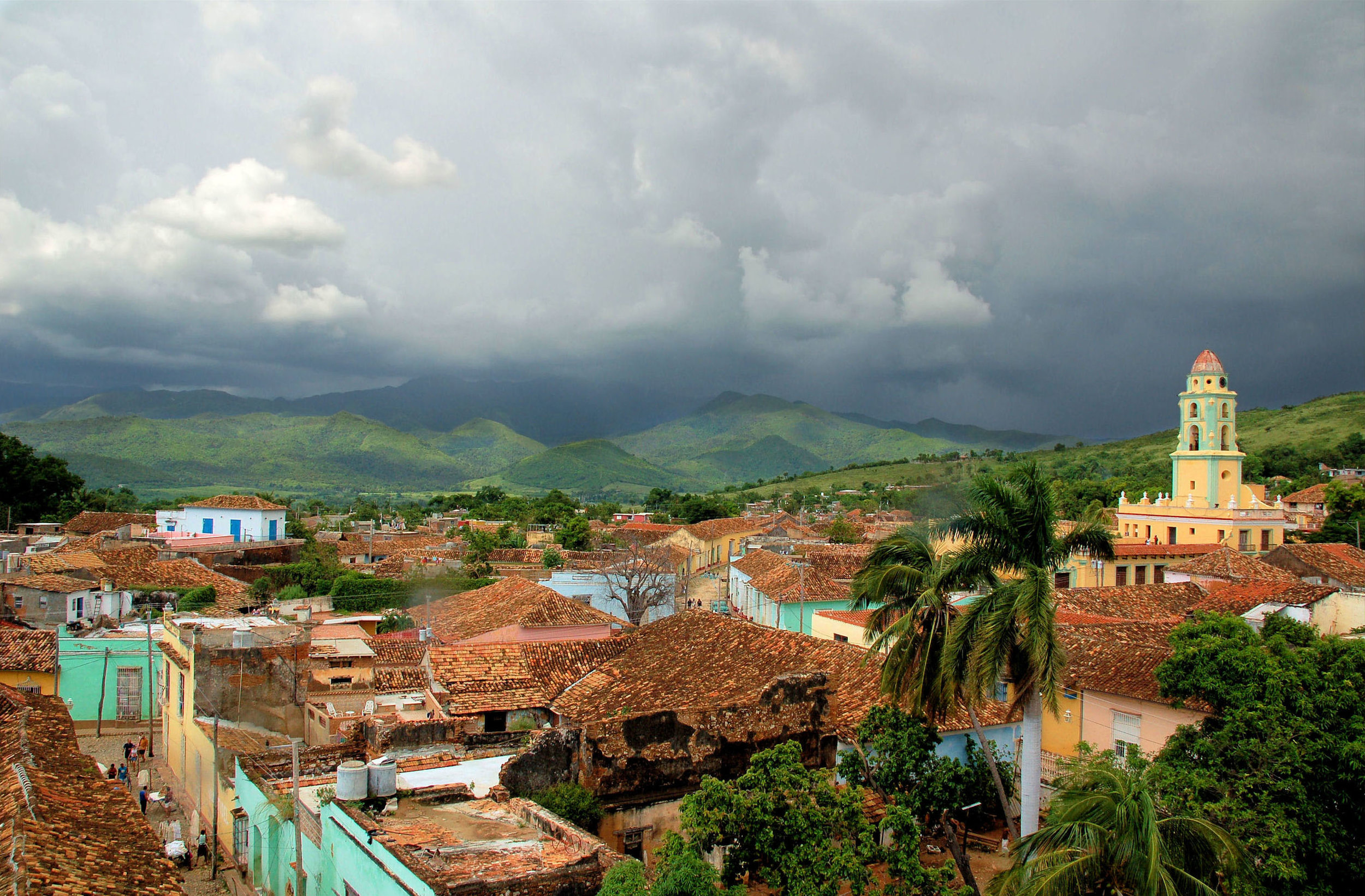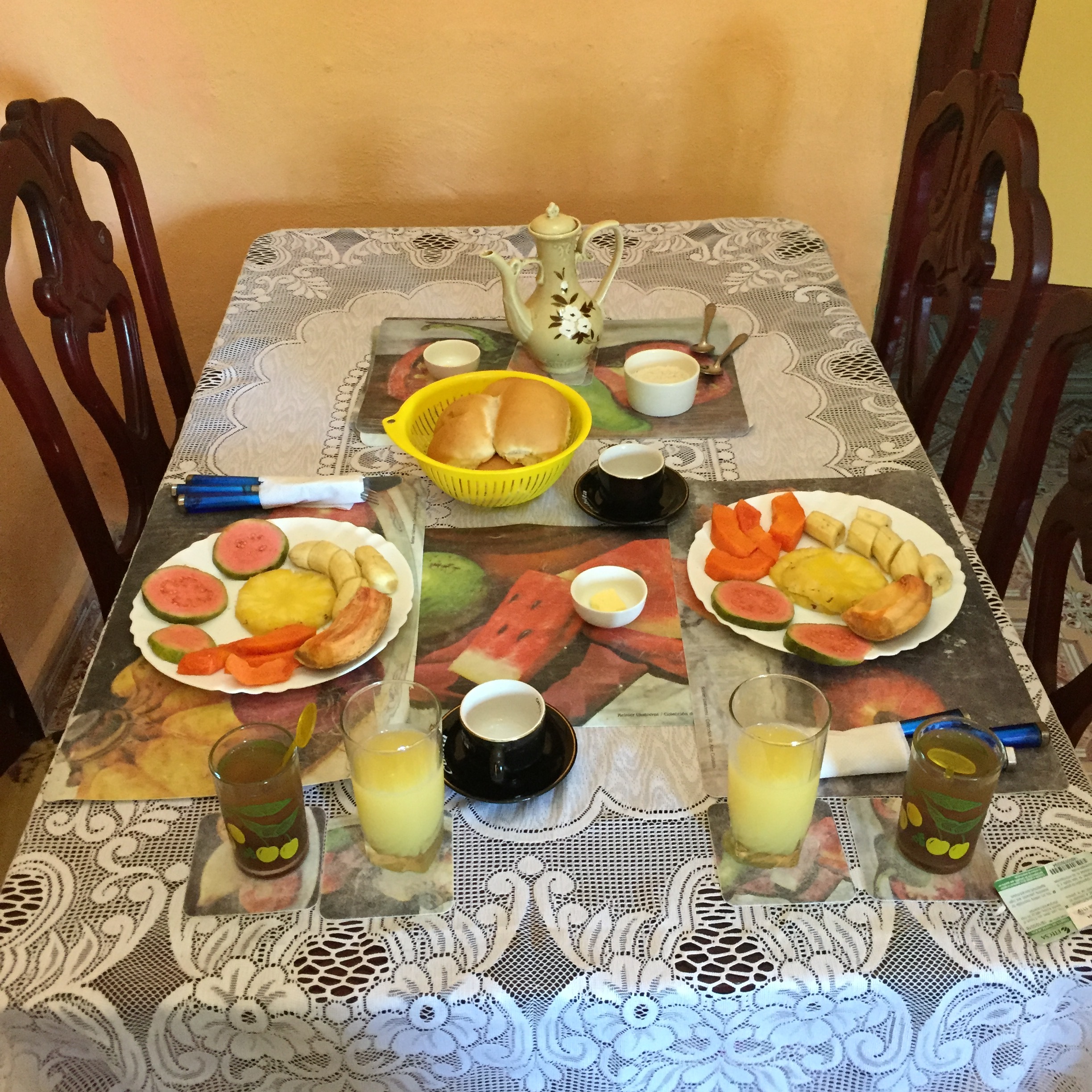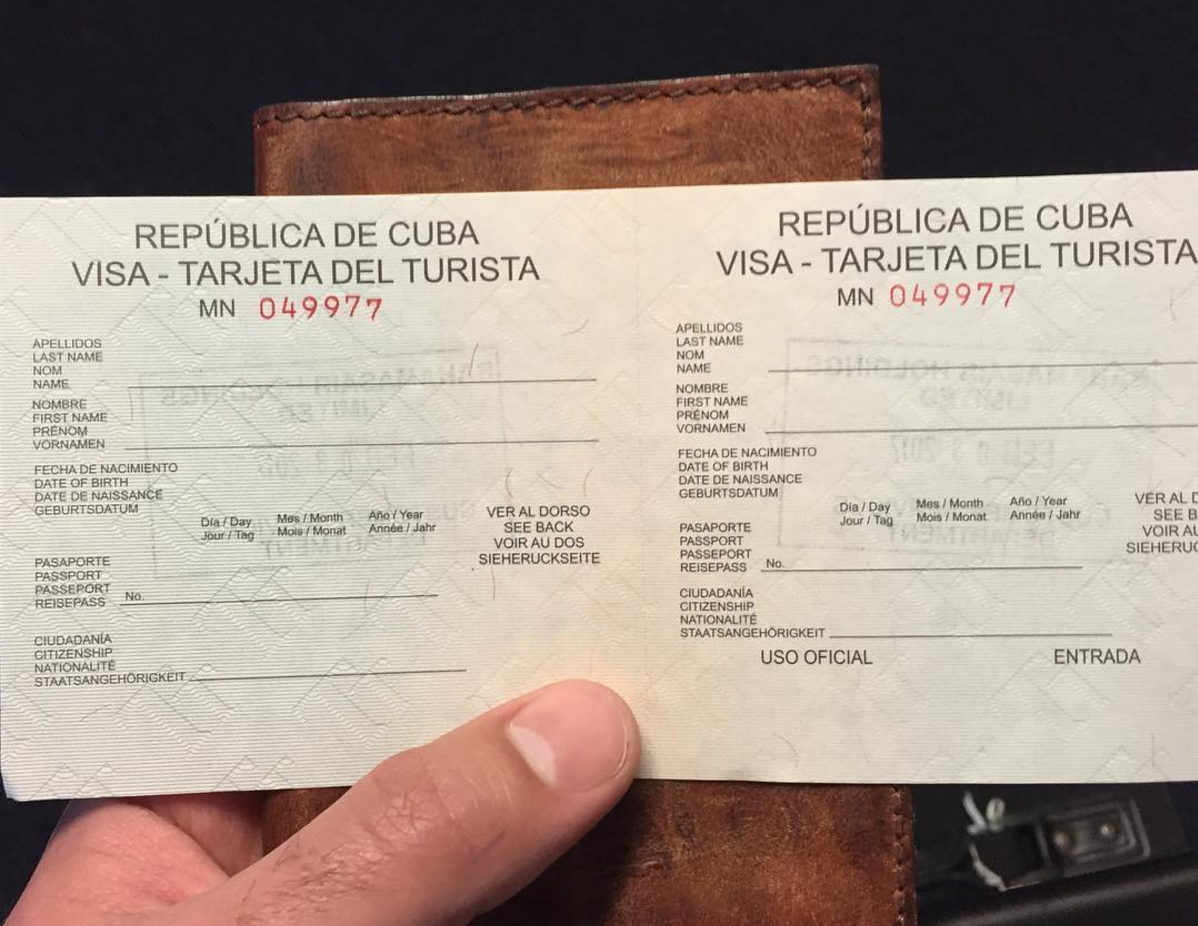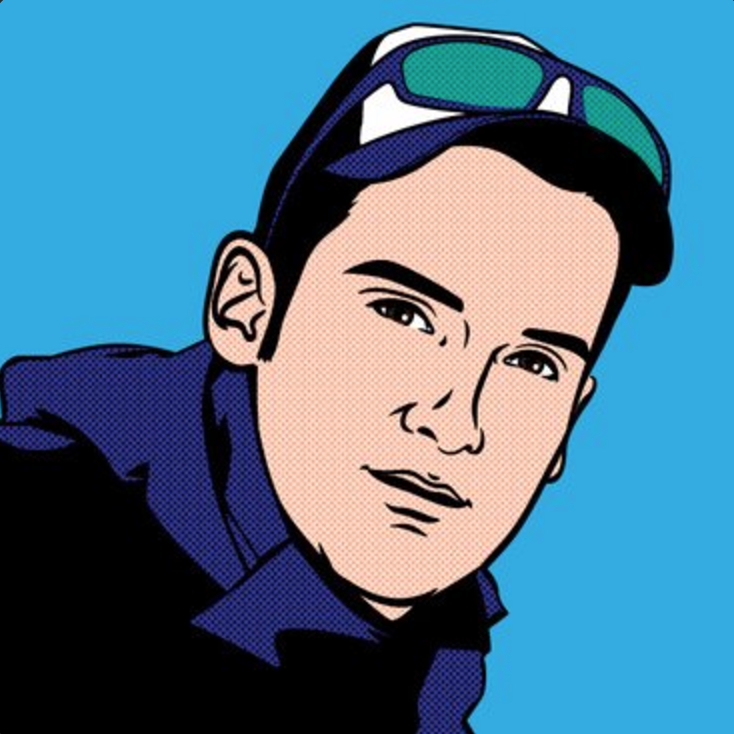A Casa Particular is your key to getting the Cuban food experience. Each one I stayed in, offered breakfast and dinner.
"You can always get breakfast at the casa particular; it’s five dollars. You will be stuffed if you finish everything that they give you," according to travel vlogger Shayla Hohiesle. "It's coffee and juice and water and bread, and then they would come with an omelette; ham and cheese is a staple in Cuba."
Jon Barr, another video blogger I spoke with, had a similar experience, "I always got a different kind of pork in the morning. Like sausage links, ham, bacon."
Cuban Breakfast
First Course of a Cuban Breakfast
"And you’re like, ‘I can’t finish this all,’ it’s way more food than you should ever eat for breakfast," Hoheisel said. "It’s so cool because you’re in their home and they’re making breakfast for you."
You’ll find ham is an option in almost every dish in Cuba. In spaghetti, in sandwiches, burgers, and salad. Beef is less common and a little more expensive.
A Casa Particular is basically like an Airbnb, you can even book one on Airbnb.com, click here for $40 dollars off an Airbnb stay for first time users. These Casas are run by local Cubans, who are great sources of information. My first host in Havana, gave me the basic run down for what I could expect to pay for, for things like coffee and meals. For long taxi rides to places like Trinidad, it’s best to ask them to book the cab for you.
You can expect to pay 25 to 30 dollars for a ride from Havana to Trinidad. These rates usually match the price of the bus fare, but you’ll arrive a lot quicker. The trip should be around 5 hours, but be prepared for an interesting trip.
"Two hours into the trip, the driver pulls over to the side of the road, and he’s like, ‘ok guys, go to the bathroom,'" said Barr.
The car I rode in, had no seat belts, and you had to adjust the windows by pulling or pushing on the glass by hand. You’re lucky if you stop at a gas station.
"Instead of going to a gas station, this guy pulls over at his house and his dad comes out with a gallon of gasoline, and literally, they’re pouring the gasoline into his car," Barr said.
Once you get to Trinidad, you’ll know why it’s worth the hassle.
Trinidad
"That was our favorite spot. All the buildings were different colors, which is so cool. And the streets were cobble stone and horse were a real means of transportation," according Hohiesle.
Trinidad was once known as the largest sugar producer in the world. At it’s peak in 1827, 56 sugar mills were in full operation. Founded in the year 1514 by Diego Velázquez, It’s cobblestone streets and historic buildings are hundreds of years old. Today, the city center is a Unesco World Heritage site.
Trinidad Sounds
Trinidad Market
"It was definitely the sounds of just hearing animals running around in the streets. The butchers chopping meet when you walked by. It seemed like every little house had something to sell, so you couldn’t walk a few feet without being surround by something completely different," Barr said.
I was woken up everyday by chickens, horses and people selling onions or garlic. Listen to the podcast episode to hear some of them:
Sugarcane
There are a lot of things to do here, like a horse backing riding tour through the sugar mills, where you can squeeze the juice out of a sugar cane.
Horseback riding
Trinidad Horseback Riding
You can find horseback riding tour in Trinidad that cost anywhere from 10 to 20 Cuc a person. Your local Cuban tour guide can take you to a coffee farm, a local waterfall, a restaurant in the mountains, or all three.
Disco Ayala
The Entrance to Disco Ayala in Trinidad
One thing unique to Trinidad is Club Ayala, a huge three story tall cave that's been converted to a nightclub. It’s hard to find, because it’s located up hill, at the highest point in Trinidad.
"We were like, waking up this hill, and I’m like, where are we going? It’s not well lit, but all of Cuba isn’t well lit. And then all of the sudden there’s like someone out on their porch with like disco lights and music and drinks," Hohiesle said.
“I didn’t know what to expect, because it was this foreign land, almost forbidden land that you weren’t allowed to go to.”
You’re going to have to walk through a residential area, on a dirt road to get to the club, where you’ll find locals bartending on their porches.
"It’s just like this homemade business for all the people on there way up to the cave. So you’re like porch hopping on your way up to this road, and all of the sudden there’s a giant line of people waiting to get into the cave," Hohiesle said. "And then you get into the cave and you go down, it’s like a normal cave that you go to during the day, but then it’s nighttime and there’re TVs on the wall and there’s a DJ, 20 feet up into the cave, 3 bars, and so many people. It was amazing and I had never been to anything like that."
Cover charge is 5 CUC, which is the Cuban Convertible Peso, and comes with one free drink.
Canchánchara
Canchánchara
The Cancháncara is a cocktail unique to Trininda.
"Canchánchara. That’s like my favorite to say but it’s also very delicious," according to Hohiesle.
It's made with lemon, ice, aguardiente (an anise flavored liquor made out of sugar cane), honey, and soda water. If you don’t have aguardiente, Cuban rum is a good alternative. They’re served in these round clay cups, also called a Canchánchara.
The two currencies
The Peso Nacional
One thing you should know about Cuba before you go, is that they have two different currencies.
"There’s the Cup and the Cuc," Hohiesle said. "The Cuc is the tourist currency, there’s literally two different bills, and then there’s the Cup.
The Cuban Convertible Peso (Cup), pronounced 'kook', is technically valued at 1 to 1 with the US Dollar, before you take exchange fees into account. Like Hohiesle said, this currency is meant for tourists. The other currency the Peso Nacional (Cup), pronounced ‘coop’. 25 Cup are worth about as much as 1 Cuc, but it can vary depending on who you ask. Cubans are paid in Cup and if you find a cafeteria for locals, you can get food for really cheap with some Cup.
Cafeterias
Cuban Cafeteria
"It’s almost like their version of fast food," Hohiesle said, "you step up to the window and then you’re out."
These places are called Cafeterias. Most of them are run out of the window of someone’s home and the prices are incredibly cheap. If you can read where it says, Pan c/ tortilla de J. y Q, you can see that its costs 12 Cup.
Cheap Bites
A 0.47 Cent Cuban Breakfast Sandwiches
That's about 0.47 cents for an egg sandwich with ham and cheese.
Visa and permission to travel
One of the most common questions people have asked me is: 'how did you go to Cuba? Don’t you need permission to go?'
The answer to that is, yes and no. So a little bit of background first: The US Embargo against Cuba restricted certain commerce and business transaction, and technically, the embargo is still in place, but there are a lot more exceptions to the rules now.
Like the new 12 reasons that give US Citizens permission to go to Cuba.
Cuba doesn’t care about these reasons, they want US travelers to visit and spend money on their economy. It's the US Department of the Treasury that created these permissions. They're very broad and I won’t get into all of them, but they range from family visits, to US government business. The most common one I’ve heard used is the, 'Support for the Cuban People,' reason.
You’ll only have to deal with these permissions twice. Once when you buy your plane ticket to Cuba online, and a second time when you return to the US through customs. When I returned, the customs agent didn’t ask me anything about my trip, he just stamped my passport and let me through.
School and Healthcare
Young Cuban Students
A lot of poor countries lack standard services like healthcare and a decent education system, but none of these things are true about Cuba.
A 2014 report by The World Bank found that Cuba has the best education system in Latin American. Students at all levels, can go to school for free, all the way up to a PhD. Cuba spends 13% of its national budget on education, the highest in the world.
All students receive free lunch and uniforms. University students get free housing and a small monthly stipend. This encourages a lot of Cubans to stay in school. Overall, the country is well educated and they have a lot of doctors.
Their healthcare system is better than any in Latin America and they have the region’s lowest infant mortality rates and the longest life expectancies. Best part about it, is it’s all free.
Free education and healthcare are great benefits for Cuban citizens, but there is a drawback.
For example, since the Cuban gov’t has complete control over the healthcare system, they determine how much healthcare workers get paid. The highest a doctor can earn is around 67 dollars a month, and there are no private medical practices either, at least no legal ones. So a lot of doctors have to work second jobs or leave the medical field all together. Other professions can easily make more money, like being a tour guide, and even street musicians can earn more.
Apps and Downloads
Maps.me
The app store for Apple or Android phones, doesn’t work in Cuba. A lot of downloadable features don’t work there either. So download all your apps and ebooks before arriving.
Download Maps.me. This isn’t a paid endorsement; this is just the best map that I’ve found to work without an internet connection.
-
We’ve covered most of the travel basics in our two Cuba podcast episodes, but there are a few more things you need to know. We’ll be covering them in our next podcast. We’re going to release an episode called the Cuba Quick Guide, where we sum up all the points we’ve made about traveling to Cuba in one short episode. We’ll even add tips like, where to buy cigars and what to pack before you go.
Thank you Shayla Hohiesle and Jon Barr for being a part of this episode.
